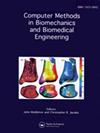应用机器学习策略识别颅内动脉瘤伴蛛网膜下腔出血的免疫相关生物标志物和免疫浸润。
IF 1.6
4区 医学
Q3 COMPUTER SCIENCE, INTERDISCIPLINARY APPLICATIONS
Computer Methods in Biomechanics and Biomedical Engineering
Pub Date : 2025-04-23
DOI:10.1080/10255842.2025.2495250
引用次数: 0
摘要
背景:蛛网膜下腔出血(SAH)的风险随着颅内动脉瘤(IA)的增加而增加,但它们之间的关系尚不清楚。方法:我们利用机器学习和生物信息学技术探索了SAH- ia的联系,鉴定了66个与ia相关的SAH基因。KEGG分析突出了NF-κB、TNF和COVID-19等途径。结果:鉴定出2个免疫相关基因(ZNF281、LRRN3),并构建了ceRNA网络。通过CMAP筛选10种潜在的SAH-IA药物。结论:ZNF281和LRRN3可能调控免疫通路(T细胞、NK细胞、巨噬细胞),影响ia相关SAH的发展,可作为治疗靶点。本文章由计算机程序翻译,如有差异,请以英文原文为准。
Identification of immune-related biomarkers and immune infiltrations of intracranial aneurysm with subarachnoid hemorrhage by machine-learning strategies.
Background: Subarachnoid hemorrhage (SAH) risk increases with intracranial aneurysms (IA), but their relationship remains unclear. Methods: We explored SAH-IA links using machine learning and bioinformatics, identifying 66 IA-related SAH genes. KEGG analysis highlighted pathways like NF-κB, TNF, and COVID-19. Results: Two immune-related genes (ZNF281, LRRN3) were identified, and a ceRNA network was constructed. Ten potential SAH-IA drugs were screened via CMAP. Conclusion: ZNF281 and LRRN3 may regulate immune pathways (T cells, NK cells, macrophages), influencing IA-related SAH development, and could serve as therapeutic targets.
求助全文
通过发布文献求助,成功后即可免费获取论文全文。
去求助
来源期刊
CiteScore
4.10
自引率
6.20%
发文量
179
审稿时长
4-8 weeks
期刊介绍:
The primary aims of Computer Methods in Biomechanics and Biomedical Engineering are to provide a means of communicating the advances being made in the areas of biomechanics and biomedical engineering and to stimulate interest in the continually emerging computer based technologies which are being applied in these multidisciplinary subjects. Computer Methods in Biomechanics and Biomedical Engineering will also provide a focus for the importance of integrating the disciplines of engineering with medical technology and clinical expertise. Such integration will have a major impact on health care in the future.

 求助内容:
求助内容: 应助结果提醒方式:
应助结果提醒方式:


